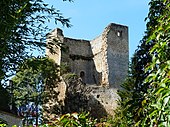Cause de Clérans
|
Cause de Clérans Cause de Clarenç |
||
|---|---|---|

|
|
|
| region | Nouvelle-Aquitaine | |
| Department | Dordogne | |
| Arrondissement | Bergerac | |
| Canton | Lalinde | |
| Community association | Bastides Dordogne-Périgord | |
| Coordinates | 44 ° 52 ′ N , 0 ° 40 ′ E | |
| height | 47-156 m | |
| surface | 14.35 km 2 | |
| Residents | 345 (January 1, 2017) | |
| Population density | 24 inhabitants / km 2 | |
| Post Code | 24150 | |
| INSEE code | 24088 | |
 Town view with castle ruins |
||
Cause-de-Clérans ( Occitan : Cause de Clarenc ) is a French municipality with 345 inhabitants (at January 1, 2017) in the department of Dordogne in the region Nouvelle-Aquitaine .
location
Cause-de-Clérans is about 70 meters above sea level. d. M. in the Dordogne department. The nearest city is Bergerac , 17 kilometers (driving distance) to the west , the capital of the arrondissement.
Population development
| year | 1962 | 1968 | 1975 | 1982 | 1990 | 1999 | 2006 | 2016 |
| Residents | 340 | 326 | 277 | 248 | 278 | 310 | 313 | 345 |
In the 19th century the community had over 700 inhabitants at times. As a result of the phylloxera crisis in viticulture and the mechanization of agriculture , the population fell to the lows in the 1970s and 1980s.
economy
In earlier times, the inhabitants of the community lived as a self-sufficient living from agriculture, which also included viticulture and the breeding of sheep and goats. Since the 1960s, the rental of holiday apartments ( gîtes ) has been added as a source of income.
history
It is unclear when exactly the two districts of Cause ( Cauzia ) and Clérans ( Clarentium ), which were mentioned in a document in the 12th century , were merged into one municipality. The castle of Clérans served the Protestants temporarily as a refuge during the religious conflicts ( Huguenot Wars ) in the second half of the 16th century.
Attractions
- The Château de Clérans in the district of the same name already existed in the 11th century, but it was burned down by Raimund I von Turenne around the year 1100. Rebuilt in the 12th and 13th centuries, it changed hands repeatedly during the Hundred Years War (1337-1453). Sold as a national good ( Bien national ) during the French Revolution , it was used as a quarry in the 19th century, but the angular keep ( donjon ) and parts of the residential wing ( corps de logis ) can still be seen. The former castle chapel with its late Gothic portal is inhabited. The entire complex has been recognized as a monument historique since 1948 .
- The parish church of Notre-Dame-de-l'Assomption in the district of Cause is a single-nave, partly Romanesque , partly early Gothic building. The eastern parts ( apse and crossing tower ) are completely unadorned, which could indicate an early date to the end of the 11th century if the stone material used were not so precisely carved. The nave and the west façade are a bit more structured and have large, immaculate windows; In addition, the three nave bays have rib vaults - all of these are indications of a significantly later date to the 13th century or even later. The crossing is covered inside by a dome on pendentives and the apse, loosened up by blind arcades on the ground floor, shows the usual vaulting of the dome . The capitals in the area of the crossing and on the arcades of the apse show 'primitive' looking animal and human figures and foliage that can hardly be interpreted. The entire interior of the church is almost uniformly covered with grout paintings and even the corner stones are painted, which gives the room a very solid look overall. The church has also been recognized as a monument historique since 1948 .
Longhouse → East
Capital of the crossing
- A roughly two meter high, unworked, vertical stone ( Mégalithe de la Malroussie ) could be attributed to the time of the megalithic cultures .
- A pigeon house ( pigeonnier ) stands in isolation on the grounds of the castle.
- A claw stand ( travail ) composed of square wooden beams from the 19th century enriches today's townscape.
Web links
Individual evidence
- ↑ Château de Clérans, Cause-de-Clérans in the Base Mérimée of the French Ministry of Culture (French)
- ↑ Église Notre-Dame-de-l'Assomption, Cause-de-Clérans in the Base Mérimée of the French Ministry of Culture (French)







